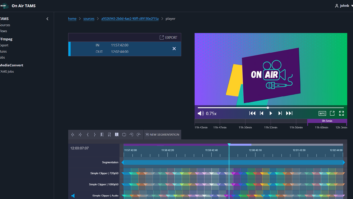
What with the amount of data on the globe continuing to increase – IBM’s figures show that we create 2.5 quintillion bytes of data every day – it’s no wonder we’re moving away from hard drives and local storage towards the cloud.
However, when it comes to media management, many companies already have huge on-premise installations with complex workflows. Suddenly moving the entire thing to a cloud environment would prove challenging right now. Instead many players are looking to start the foray into this new way of thinking using a combination of both cloud environments and on-premise storage. We call this the hybrid cloud, offering the flexibility of the cloud and instant access to media assets, while also maintaining the reassurance of on-premise storage and instant access to your media files when needed.
What exactly is a hybrid environment?
A hybrid environment is exactly that, a combination of cloud and on-premise. It means content owners can continue to utilise the existing infrastructure, but it gives them a much-needed extension of that using cloud functionality. For some content providers, a fully cloud approach might make sense. However, for many providers, simply getting rid of a well-functioning, and often complex, on-premise infrastructure is not an option and would be counter-intuitive.
A hybrid approach maximises the best of both worlds, meaning you can move only the data to the cloud that makes sense for you, which of course means you are not having to pay for masses of cloud data storage unless you really need it. You can also continue to have instant access to all of your files. By automatically extracting metadata and generating proxies of your local high-resolution files, you can reduce the amount of data in the cloud, whilst still being able to collaborate globally.
A hybrid environment also means you can connect multiple SANs and NAS’s, even if they are located in different geographic regions.
Is a hybrid approach right for you?
One of the many benefits of a cloud setup is elasticity, primarily the freedom to scale up almost every module of the service during times of demand (including processing power, servers, storage etc.), and scale down when unnecessary. With a truly efficient media management solution, the management layer, or mothership as we like to call it, takes control of the storage in such a way that the complex workflows are as transparent to the user as possible.
Even those on smaller budgets can invest in the cloud because they don’t have to guess how much storage or processing power they need, for example, and can be assured that the platform will automatically scale this down to make savings when needed. With hybrid solutions, this is even more relevant, considering that content only needs to reside in the cloud on occasion, and can be kept on-premise when necessary.
For users in numerous locations, the cloud can provide instant sharing of content and collaboration without leaving the secure domain of the media management software. On top of this, if content must be reviewed or edited by personnel in different locations, the cloud can significantly streamline the workflow. With a powerful management system overseeing operations, proxy workflows can enable edits to be recorded within the original content, without the need to move large files using considerable bandwidth. This is all to do with evaluating the stage at which a piece of content is at in the workflow and is imperative when considering the move to the cloud.
The type of individuals using the management system must also be considered, particularly for users that aren’t media professionals perhaps creating video for corporate use. Simple interfaces are key for this type of user so they can get the benefits of a hybrid cloud management system, without needing to spend time becoming an expert.
Ultimately, however almost every organisation can benefit from an off-site cloud component, as it means they can cost-effectively build on this as needed, expanding from say, 2 to 20,000 users, or 1TB to 1PB of storage, without needing to manually alter the infrastructure. A recent survey from Tech Target found that 55% of respondents answered the question “what is driving your new cloud storage purchase”, with “to address growing data volume”. This tells us that hybrid cloud solutions are likely to become even more prolific in time, given that their very nature enables the ability to consistently grow upwards in capacity.
How to make the most of a hybrid cloud solution
Despite the fact that most companies can benefit from the hybrid approach, it is important to remember that different companies have different media management needs and different workflows. A hybrid cloud media management approach shouldn’t necessarily change how you’re working today, instead it should significantly extend and improve it.
How to find out? Well, the cost of getting started is minimum. Start with identifying and solving the immediate problems, confirm that the platform is in fact right for you, and once confirmed, scale up to address other needs. No need to invest large amount of CAPEX for a solution that can potentially address your needs. Basically: start small, think big, grow fast!
In vogue or innovation?
At its simplest, the main purpose of implementing a media management solution is to save time for other revenue generating activities. Inevitably, enabling global collaboration, finding content faster and automating file movement means users spend less time managing content and more time putting it to good use. The cloud is going to become central to the evolving media management industry, as video becomes the primary medium of communication of our age and more and more content is produced.





